The Covalent Bonds of Cake-baking and the Covenantal Bonds of 2 Samuel 8-10
Made some petit fours for someone's birthday last week. She's a great fan of the colour pink so dyed the white chocolate topping pink and sprinkled pink sea flakes on the rest of the mini-cakes.
They were accompanied by a small syringe of cream cheese - for those who might want a little extra on the side.
The bottom row: the result of cake mixture baked in an oven that was moseying up to the desired temperature because someone couldn't be bothered to preheat it. The middle row: the result of cake mixture baked in a preheated (by default) oven. The empty space in the top row: the result of not putting up "Eat and Die!" signs when the cakes are cooling.
This week, someone else asked for a blackforest cake (black forest gauteux to Brits) for her birthday, at which point, Eddie Izzard's "Cake or Death" routine came to mind. In the context of my baking, the only response would be,"Oooh, I'll have the cake and the death please, if you don't mind."
There is no love lost between the BFG and I: sponge? Bland. Whipped cream? Boring calories. Maraschino cherries? Like eating plastic. Still, googled some recipes, all at some sort of variance with each other. At which point, baking recipes seemed a repository of old wives tales asking to be taken with a heavy dose of stupidly blind faith. Might as well believe that ugly people sour the cream, bathing naked under the full moonlight in the Singapore River will give you SKII-clear skin and praying over the new TV will keep the follically-endowed Sadako from emerging therefrom. Oh, wait. Some people do believe such things.
In line with the constant need to know the whys, hows and whatfors of things that used to traumatise teachers and make priests almost lose their faith, decided it was best to first investigate science behind a basic cake.
Alot of science is made up of theories about material phenomena and explanations of interactions and correlations between multiple phenomena. And theories are really mere hypotheses, to be confirmed for the meanwhile or to be disproved at the next experiment.

Still, without adequate resources, equipment and guinea pigs to test all theories out for myself, we takes what we can gets for now. It's amazing how much complexity there is behind the 4 basic ingredients for a cake: eggs, sugar, flour and fat. It's also amazing the sort of books we have in the national/community libraries of Singapore.
Most recipes for sponge cake insist on either baking soda, baking powder or self-raising flour. From using sodium bicarbonate and diluted hydrochloric acid and red dye to simulate a stomach bursting under Japanese water torture in history class, and from whatever little knowledge gleaned from chemistry class, remember baking soda as an alkali. Therefore its use in sponge cakes is probably to, through its reaction with other ingredients, produce carbon dioxide that would make the cake rise into required sponginess.

Pierre Hermé however, in Chocolate Desserts, does not require the addition of an alkali. Instead, he advocates the whipping of the egg whites and egg yolks separately, then folding the whipped whites and other ingredients into the yolks.
Some sort of sponge cake method? Peter Barham (of the famous Physics of the Black Forest Gauteux lectures at Bristol) gives this probably rather simplistic for-the-layman explanation in The Science of Cooking:
Genoese (Génoise) Sponge Cake
The best sponge cakes are those with most and smallest bubbles when cooked. Genoese sponge cakes do not use a raising agent as baking powder, but rather the bubbles are made before the cake is put in the oven. The bubbles are in the form of an egg foam. The other ingredients are then gently added to the foam so as not to break any of the carefully prepared bubbles and then the cake is cooked. The cake rises a little during the cooking as the air inside the bubbles expands and as some steam is generated. In the oven, the heat crosslinks and coagulates the egg proteins and so sets the cake.
Eggs

Egg whites are made of proteins. Proteins themselves are made up of amino acids held together by internal hydrogen bonds. Hydrogen bonds are...well, to paraphrase John Polyani "chemist-speak for 'it makes atoms stick together but we don't know why'."
The aim of whipping the egg white is to break down the hydrogen bonds from their natural state ("denaturation") to incorporate the air bubbles. Denaturation occurs by heat (egg proteins denature at 40 degrees celcius) and by stretching the molecules through agitation.

Harold McGee in On Food And Cooking adds that ovalbumin, the major protein in egg white, is relatively immune to beating and doesn't contribute much to the raw foam. However, it is sensitive to hear, which causes it to unfold and coagulate. So when the raw foam is cooked, ovalbumin more than doubles the amount of solid protein reinforcement in the bubble walls. At the same time, much of the free water in the foam evaporates.
There is some fat present in the egg yolk, which decreases the ability of the proteins to foam well, analogous to the disappearance of washing up bubbles when oily dishes are added. Which is why Monsieur Pierre recommends the segregation of the white and yolk for whipping.
Also, not all eggs are created equal. McGee gives some pointers: old eggs at room temperature are often recommended on the grounds that the whites are thinner and therefore foam more rapidly. This is true, and very fresh eggs are said to be almost impossible to foam by hand. But fresh eggs are less alkaline and so make a more stable foam; the older thin white also drains from the foam more easily, and old eggs are more likely to leave traces of yolk in the white. Cold yolks are less likely to break as you separate them from the whites, and the whipping process quickly warms cold eggs anyway.
Both Barham and McGee concur about the apparent magical qualities of beating eggs in copper bowls: copper has the useful tendency to form extremely tight bonds with reactive sulfur groups: so tight that the sulfur is essentially prevented from reacting with anything else (sounds like TomKat to me). So the presence of copper in foaming egg whites essentially eliminates the strongest kind of protein bond that can form, and makes it harder for the proteins to embrace each other too tightly.
Sugar

If the egg foam is the tenous framework, then the sugar acts as the reinforcement bars. Sugar increases the viscosity or "thickness" of the egg.
McGee: by making the liquid thick and cohesive, sugar greatly slows drainage from the bubble walls and coarsening of texture. In the oven, the dissolved sugar hangs onto the water molecules and so delays their evaporation in the high heat after ovalbumin has had time to coagulate and reinforce the raw foam. And it eventually contributes reinforcement of its own in the form of fine by solid, cotton-candy-like strands of dry sugar.
McGee also warns that the addition of sugar early in the foaming process actually reduces the foam's ultimate volume and lightness. The delay comes from sugar's interference with the unfolding and bonding of the proteins. And the reduction in volume and lightness is caused by the syrupy sugar-egg mixture being harder to spread into thin bubble walls. Useful for equipment-challenged people like me who have to hand-whip the stuff.
Flour
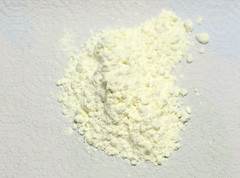
The flour acts like concrete. The starch is a reinforcing agent which stiffens and strengthens the egg foam. Without starch, the egg foams even when cooked would not be strong enough to support the cake filling. There is also some cross-linking of proteins to starch during cooking.
Fat (butter or oil)
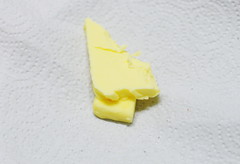
This acts as an anti-staling agent which slows down the rate at which water consorts with the starch and turns the cake stale. It also adds flavour and texture to the cake. It is quite possible to make perfectly acceptable cakes without adding any fats but they would become stale in just an hour or two.
McGee opines that solid fats also retain air bubbles thanks to their semisolid consistency. When beaten together with sugar, the air carried along by the sugar crystals and beater becomes immobilised in the mixture of crystalline and liquid fat. And while butter is still the fat of choice for bakers who value flavour over lightness of texture, modern vegetable shortenings do a better job of incorporating air bubbles into cake batter.
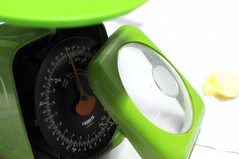
Armed with these hypotheses, I came up with this plan for making the sponge layer of the BFG without chocolate:
This first experiment was meant to test the difference between the use of plain flour and cake flour. Cake flour has less protein than plain flour and I wanted to see if this would result in less moisture retention and a more poofy cake. Unfortunately, I got too bored waiting for the cake-floured cake to bake, wandered off and left it in the oven for too long, thereby inadvertently introducing another variable into the experiment. I might also have used a different higher temperature for the second cake. Nevermind, I thought, I'll just do a taste test when I get home from work to see what can be gleaned. But when I got home, the cakes had been eaten by person or person(s) unknown. Their crushed containers lay empty in the bin. I bet Pierre and Marie Curie never had this sort of problem.
Anyway, someone owned up later by saying that although the cakes were very yummy, one of them was a bit on the dense side. Not quite the very sponginess the birthday girl had requested. The unwitting guinea pig not having paid much attention to which one he had eaten, I could only guess that the reference was to the cake flour model. Was this the consequence of its length of time in the oven, the low-protein of the flour or the ratio of flour to sugar and fat?
The second experimental batch spent less time in the oven. I replaced some of the flour with cocoa powder (Valrhona, therefore dutch-processed, cocoa powder apparently having the ability to take on some of the water-absorbing and structural duties of flour, being about 50% carbohydrate and 20% non-gluten protein) and added melted chocolate to the melted butter, thereby introducing far too many variables for this to be a proper experiment.
These ugly chaps were tasty and small of crumb but still too dense for a spongey sponge. Did I fold in with too heavy a hand? Did the cocoa powder and chocolate take in too much water?
The experiments continue...
...as does our womble through the second book of Samuel. 2 Samuel 8-10 reminded me how, just as we put our faith in scientific theories because the stated results have been proved over and over again through numerous experiments, so we put our faith in God not with the blindfolds on but because he has proved over and over again that he can be trusted.
In 2 Samuel 7:9, God had promised to make for David "a great name, like the name of the great ones of the earth". Fast forward to 2 Samuel 8:1-14 and David did indeed defeat the Philistines, the Moabites, Hadadezer king of Zobah, the Syrians and the Edomites and he defeats the Ammonites in 2 Samuel 10. Through his conquests and victories, David made a name for himself (2 Samuel 8:13) or rather, it was God who made a great name for David, for it was God who gave David the victories (2 Samuel 8:6,14).
And not only were David's victories a fulfilment of God's promises to him, they were also a fulfilment of God's promises to Abraham about a thousand years before. In Genesis 15, God had covenanted with Abraham concerning roughly the same geographical area:
God's promises were being fulfilled (in part) through his chosen king David and David too modelled some of God's covenantal faithfulness. In his younger days, desperate and fearful for his life, David had made a covenant with Jonathan not to cut off his steadfast love from Jonathan's house forever, even when the LORD cut off every one of David's enemies from the face of the earth (1 Samuel 20:14-15). With Jonathan dead and no witnesses to the covenant, David could easily have ignored it, or dismissed it as youthful folly. Instead, not only did he not kill Jonathan's remaining son, Mephibosheth, the obvious rival to the throne, he also heaped generous kindness on him: bestowing upon him the privilege of eating at the king's table (2 Samuel 9:7,9,13) and also restoring to him all the lands of his grandfather Saul and servants to work the land so that he and his family would be well-provided for (2 Samuel 9:7-13).
But, as suggested by the reference to a future king who would be both David's offspring and God's own son (2 Samuel 7:12-16) David was merely a foreshadowing of God's perfect anointed king to come. His name was Jesus, through whom (as Yuk Yee pointed out) God showed generous kindness to us: while we were still enemies, Christ died for us. Very rarely would anyone die for a righteous man, though for a good man someone might possibly dare to die. Yet Christ died for the benefit of undeserving sinners (Romans 5:6-8).
And through Jesus' death, he gained victory over more than physical territory. He destroyed the devil who had the power of death over us and so delivered us from the slavery of death (Hebrews 2:14-15). And having gained victory over more than just terra, Jesus' rule was and is over and above everything: all rule and authority and power and dominion, and above every name that is named, not only in this age but also in the one to come (Ephesians 1:21).
If Jesus rules over all things, then there is no opting in or out of his rule. The choice lies in acknowledging this reality or living as Jesus' enemies, to our future and eternal detriment.
__________________________________
They were accompanied by a small syringe of cream cheese - for those who might want a little extra on the side.
The bottom row: the result of cake mixture baked in an oven that was moseying up to the desired temperature because someone couldn't be bothered to preheat it. The middle row: the result of cake mixture baked in a preheated (by default) oven. The empty space in the top row: the result of not putting up "Eat and Die!" signs when the cakes are cooling.
This week, someone else asked for a blackforest cake (black forest gauteux to Brits) for her birthday, at which point, Eddie Izzard's "Cake or Death" routine came to mind. In the context of my baking, the only response would be,"Oooh, I'll have the cake and the death please, if you don't mind."
There is no love lost between the BFG and I: sponge? Bland. Whipped cream? Boring calories. Maraschino cherries? Like eating plastic. Still, googled some recipes, all at some sort of variance with each other. At which point, baking recipes seemed a repository of old wives tales asking to be taken with a heavy dose of stupidly blind faith. Might as well believe that ugly people sour the cream, bathing naked under the full moonlight in the Singapore River will give you SKII-clear skin and praying over the new TV will keep the follically-endowed Sadako from emerging therefrom. Oh, wait. Some people do believe such things.
In line with the constant need to know the whys, hows and whatfors of things that used to traumatise teachers and make priests almost lose their faith, decided it was best to first investigate science behind a basic cake.
Alot of science is made up of theories about material phenomena and explanations of interactions and correlations between multiple phenomena. And theories are really mere hypotheses, to be confirmed for the meanwhile or to be disproved at the next experiment.

Still, without adequate resources, equipment and guinea pigs to test all theories out for myself, we takes what we can gets for now. It's amazing how much complexity there is behind the 4 basic ingredients for a cake: eggs, sugar, flour and fat. It's also amazing the sort of books we have in the national/community libraries of Singapore.
Most recipes for sponge cake insist on either baking soda, baking powder or self-raising flour. From using sodium bicarbonate and diluted hydrochloric acid and red dye to simulate a stomach bursting under Japanese water torture in history class, and from whatever little knowledge gleaned from chemistry class, remember baking soda as an alkali. Therefore its use in sponge cakes is probably to, through its reaction with other ingredients, produce carbon dioxide that would make the cake rise into required sponginess.

Pierre Hermé however, in Chocolate Desserts, does not require the addition of an alkali. Instead, he advocates the whipping of the egg whites and egg yolks separately, then folding the whipped whites and other ingredients into the yolks.
Some sort of sponge cake method? Peter Barham (of the famous Physics of the Black Forest Gauteux lectures at Bristol) gives this probably rather simplistic for-the-layman explanation in The Science of Cooking:
Genoese (Génoise) Sponge Cake
The best sponge cakes are those with most and smallest bubbles when cooked. Genoese sponge cakes do not use a raising agent as baking powder, but rather the bubbles are made before the cake is put in the oven. The bubbles are in the form of an egg foam. The other ingredients are then gently added to the foam so as not to break any of the carefully prepared bubbles and then the cake is cooked. The cake rises a little during the cooking as the air inside the bubbles expands and as some steam is generated. In the oven, the heat crosslinks and coagulates the egg proteins and so sets the cake.
Eggs

Egg whites are made of proteins. Proteins themselves are made up of amino acids held together by internal hydrogen bonds. Hydrogen bonds are...well, to paraphrase John Polyani "chemist-speak for 'it makes atoms stick together but we don't know why'."
The aim of whipping the egg white is to break down the hydrogen bonds from their natural state ("denaturation") to incorporate the air bubbles. Denaturation occurs by heat (egg proteins denature at 40 degrees celcius) and by stretching the molecules through agitation.

Harold McGee in On Food And Cooking adds that ovalbumin, the major protein in egg white, is relatively immune to beating and doesn't contribute much to the raw foam. However, it is sensitive to hear, which causes it to unfold and coagulate. So when the raw foam is cooked, ovalbumin more than doubles the amount of solid protein reinforcement in the bubble walls. At the same time, much of the free water in the foam evaporates.
There is some fat present in the egg yolk, which decreases the ability of the proteins to foam well, analogous to the disappearance of washing up bubbles when oily dishes are added. Which is why Monsieur Pierre recommends the segregation of the white and yolk for whipping.
Also, not all eggs are created equal. McGee gives some pointers: old eggs at room temperature are often recommended on the grounds that the whites are thinner and therefore foam more rapidly. This is true, and very fresh eggs are said to be almost impossible to foam by hand. But fresh eggs are less alkaline and so make a more stable foam; the older thin white also drains from the foam more easily, and old eggs are more likely to leave traces of yolk in the white. Cold yolks are less likely to break as you separate them from the whites, and the whipping process quickly warms cold eggs anyway.
Both Barham and McGee concur about the apparent magical qualities of beating eggs in copper bowls: copper has the useful tendency to form extremely tight bonds with reactive sulfur groups: so tight that the sulfur is essentially prevented from reacting with anything else (sounds like TomKat to me). So the presence of copper in foaming egg whites essentially eliminates the strongest kind of protein bond that can form, and makes it harder for the proteins to embrace each other too tightly.
Sugar

If the egg foam is the tenous framework, then the sugar acts as the reinforcement bars. Sugar increases the viscosity or "thickness" of the egg.
McGee: by making the liquid thick and cohesive, sugar greatly slows drainage from the bubble walls and coarsening of texture. In the oven, the dissolved sugar hangs onto the water molecules and so delays their evaporation in the high heat after ovalbumin has had time to coagulate and reinforce the raw foam. And it eventually contributes reinforcement of its own in the form of fine by solid, cotton-candy-like strands of dry sugar.
McGee also warns that the addition of sugar early in the foaming process actually reduces the foam's ultimate volume and lightness. The delay comes from sugar's interference with the unfolding and bonding of the proteins. And the reduction in volume and lightness is caused by the syrupy sugar-egg mixture being harder to spread into thin bubble walls. Useful for equipment-challenged people like me who have to hand-whip the stuff.
Flour

The flour acts like concrete. The starch is a reinforcing agent which stiffens and strengthens the egg foam. Without starch, the egg foams even when cooked would not be strong enough to support the cake filling. There is also some cross-linking of proteins to starch during cooking.
Fat (butter or oil)

This acts as an anti-staling agent which slows down the rate at which water consorts with the starch and turns the cake stale. It also adds flavour and texture to the cake. It is quite possible to make perfectly acceptable cakes without adding any fats but they would become stale in just an hour or two.
McGee opines that solid fats also retain air bubbles thanks to their semisolid consistency. When beaten together with sugar, the air carried along by the sugar crystals and beater becomes immobilised in the mixture of crystalline and liquid fat. And while butter is still the fat of choice for bakers who value flavour over lightness of texture, modern vegetable shortenings do a better job of incorporating air bubbles into cake batter.

Armed with these hypotheses, I came up with this plan for making the sponge layer of the BFG without chocolate:
- preheat oven (since it is a race against time to immobilise the air bubbles in the egg foam which would have started collapsing with the addition of the fat and egg yolk mixture. Also if the batter sets slowly, the expanding air bubbles can coalesce to produce a coarse, heavy texture)
- melt butter (ensures time taken to mix in butter is minimised, thus reducing amount of collapse of egg foam)
- repair very old weighing machine, then measure out flour and sugar (no sifting because unlike what most books say apparently, sifting does nothing to aerate the mixture later. The sifting was a historical requirement to preclude weevil or mouse-dropping flavoured cakes)
- whisk egg yolk and sugar together until pale yellow (colour being a guide to the size of the bubbles in the mixture. Theoretically, smaller particles will reflect back more light in all directions, making the object appear to be a colour nearer the white-side of the spectrum)
- whisk egg white, adding sugar only after soft peaks form
- fold in everything in quickly "with a light hand" (again to minimise collapse of egg foam)
- pop in oven
- remember to check oven
This first experiment was meant to test the difference between the use of plain flour and cake flour. Cake flour has less protein than plain flour and I wanted to see if this would result in less moisture retention and a more poofy cake. Unfortunately, I got too bored waiting for the cake-floured cake to bake, wandered off and left it in the oven for too long, thereby inadvertently introducing another variable into the experiment. I might also have used a different higher temperature for the second cake. Nevermind, I thought, I'll just do a taste test when I get home from work to see what can be gleaned. But when I got home, the cakes had been eaten by person or person(s) unknown. Their crushed containers lay empty in the bin. I bet Pierre and Marie Curie never had this sort of problem.
Anyway, someone owned up later by saying that although the cakes were very yummy, one of them was a bit on the dense side. Not quite the very sponginess the birthday girl had requested. The unwitting guinea pig not having paid much attention to which one he had eaten, I could only guess that the reference was to the cake flour model. Was this the consequence of its length of time in the oven, the low-protein of the flour or the ratio of flour to sugar and fat?
The second experimental batch spent less time in the oven. I replaced some of the flour with cocoa powder (Valrhona, therefore dutch-processed, cocoa powder apparently having the ability to take on some of the water-absorbing and structural duties of flour, being about 50% carbohydrate and 20% non-gluten protein) and added melted chocolate to the melted butter, thereby introducing far too many variables for this to be a proper experiment.
These ugly chaps were tasty and small of crumb but still too dense for a spongey sponge. Did I fold in with too heavy a hand? Did the cocoa powder and chocolate take in too much water?
The experiments continue...
...as does our womble through the second book of Samuel. 2 Samuel 8-10 reminded me how, just as we put our faith in scientific theories because the stated results have been proved over and over again through numerous experiments, so we put our faith in God not with the blindfolds on but because he has proved over and over again that he can be trusted.
In 2 Samuel 7:9, God had promised to make for David "a great name, like the name of the great ones of the earth". Fast forward to 2 Samuel 8:1-14 and David did indeed defeat the Philistines, the Moabites, Hadadezer king of Zobah, the Syrians and the Edomites and he defeats the Ammonites in 2 Samuel 10. Through his conquests and victories, David made a name for himself (2 Samuel 8:13) or rather, it was God who made a great name for David, for it was God who gave David the victories (2 Samuel 8:6,14).
And not only were David's victories a fulfilment of God's promises to him, they were also a fulfilment of God's promises to Abraham about a thousand years before. In Genesis 15, God had covenanted with Abraham concerning roughly the same geographical area:
To your offspring I give this land, from the river of Egypt to the great river, the river Euphrates, the land of the Kenites, the Kenizzites, the Kadmonites, the Hittites, the Perizzites, the Rephaim, the Amorites, the Canaanites, the Girgashites and the Jebusites. (Genesis 15:18-21)This was also the land God had promised Israel, the place where he would "plant them, so that they may dwell in their own place and be disturbed no more. And violent men shall afflict them no more, as formerly, from the time that I appointed judges over my people Israel" (2 Samuel 7:10).
God's promises were being fulfilled (in part) through his chosen king David and David too modelled some of God's covenantal faithfulness. In his younger days, desperate and fearful for his life, David had made a covenant with Jonathan not to cut off his steadfast love from Jonathan's house forever, even when the LORD cut off every one of David's enemies from the face of the earth (1 Samuel 20:14-15). With Jonathan dead and no witnesses to the covenant, David could easily have ignored it, or dismissed it as youthful folly. Instead, not only did he not kill Jonathan's remaining son, Mephibosheth, the obvious rival to the throne, he also heaped generous kindness on him: bestowing upon him the privilege of eating at the king's table (2 Samuel 9:7,9,13) and also restoring to him all the lands of his grandfather Saul and servants to work the land so that he and his family would be well-provided for (2 Samuel 9:7-13).
But, as suggested by the reference to a future king who would be both David's offspring and God's own son (2 Samuel 7:12-16) David was merely a foreshadowing of God's perfect anointed king to come. His name was Jesus, through whom (as Yuk Yee pointed out) God showed generous kindness to us: while we were still enemies, Christ died for us. Very rarely would anyone die for a righteous man, though for a good man someone might possibly dare to die. Yet Christ died for the benefit of undeserving sinners (Romans 5:6-8).
And through Jesus' death, he gained victory over more than physical territory. He destroyed the devil who had the power of death over us and so delivered us from the slavery of death (Hebrews 2:14-15). And having gained victory over more than just terra, Jesus' rule was and is over and above everything: all rule and authority and power and dominion, and above every name that is named, not only in this age but also in the one to come (Ephesians 1:21).
If Jesus rules over all things, then there is no opting in or out of his rule. The choice lies in acknowledging this reality or living as Jesus' enemies, to our future and eternal detriment.
__________________________________
- The Myanmar-Sichuan Double Disasters, Ironman and Watchmen, and 2 Samuel 21 - 24
- Dead Dogs, Dead Cows and Dead Men in 2 Samuel 19 - 20
- Chek Jawa, the 37.96km Ride Along the Eastern Coastal Park Connector etc and 2 Samuel 14 - 18
- Inevitabilities, Boat Asia, Strawberries, 五月天 (wuyuetian, MayDay)'s 回到地球表面 (Down To Earth) Concert and 2 Samuel 12
- Black Forest Gateaux Cupcake Experiments and the Dosh on David in 2 Samuel 11
- Operation Leftover Easter Stuff: Chocolate Experiments in the Physiology of Taste and 2 Samuel 7
- The Return of Sunshine and the Return of the Ark in 2 Samuel 6
- Operation Leftover Easter Stuff: Reconstructed Deconstructed Lemon Meringue Tart and 2 Samuel 1 - 4
Labels: 2 Samuel, All Given For Food: Bake and Cake, All Given For Food: Cherries, All Given For Food: Cupcakes, All Given For Food: Kitchen Experiments that apparently approximate "Molecular Gastronomy"

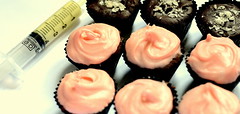
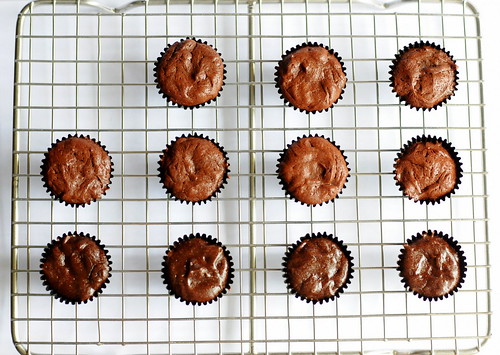
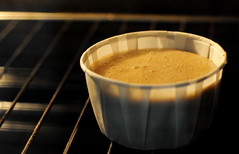

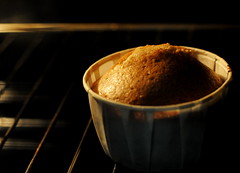
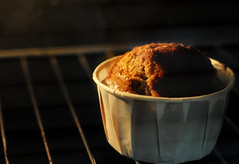
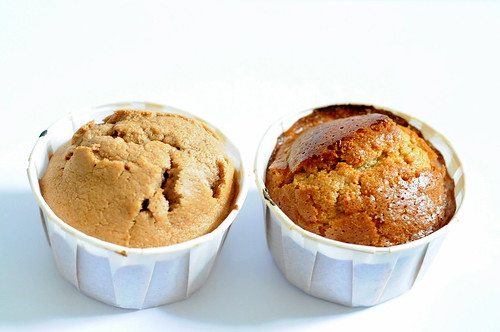
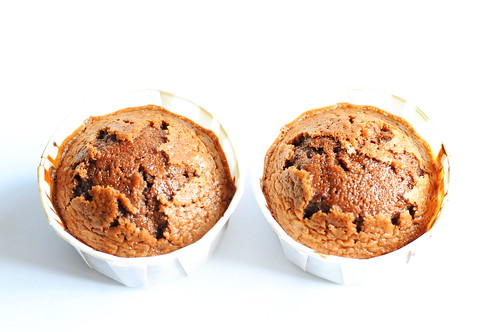








1 Comments:
i'm glad the baking trend is finally hitting asia! greedy ol' me gets all excited reading blogs here at work.
btw you should try baking bread too. check out michelle's hubby alec on this.
w is a trainee chef and amazing photographer. check out her blog too!
all the best! dan
Post a Comment
Subscribe to Post Comments [Atom]
<< Home